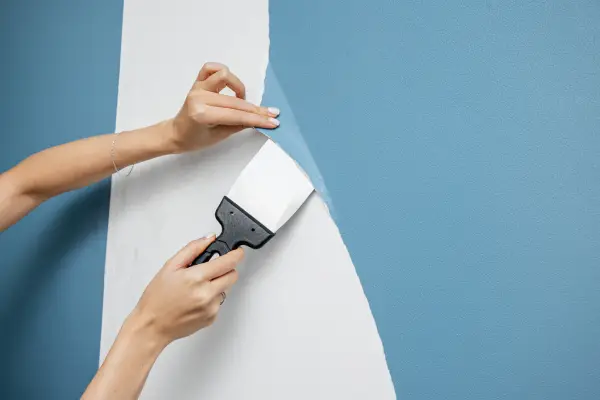How Long Does Wallpaper Removal Take?

Wallpaper goes in and out of fashion, and it's often used to make a dramatic statement or to cover up a wall that might otherwise need some serious repairs. While it does a good job at what it's supposed to do, it can be a little trickier to remove when you decide it's time for a change.
One common question that halts homeowners in their tracks: How long does it take to remove wallpaper? Although this depends on the age, type, amount of wallpaper, and condition of the wall, it typically takes a day to remove it.
Read on to learn how to remove wallpaper:
- How long does it take to remove wallpaper
- How to assess wallpaper removal difficulty
- Find a Five Star Painting wallpaper professional near you
How Long Does It Take to Remove Wallpaper?
As mentioned, many factors impact how long it will take you to remove wallpaper, including age, type, the amount of wallpaper you’re removing, and the condition of the wall surface underneath. On average, it takes about a day to strip the walls of a small bedroom, but there are a few factors that could stretch that timeline.
Some of those factors include:
- Age: Newer wallpapers installed in the last few years are typically easier to remove because they often have a weaker adhesive, which makes peeling them off the wall less work. Also, if the new wallpaper has not been exposed to moisture or high temperatures, it will require less effort to remove. However, older wallpapers are often a different story. Removal is not only more difficult, but it's a messy job that requires a lot of cleanup. In many cases, removing older wallpaper damages the wall underneath due to the extra effort required to remove it. Therefore, time must be taken to repair the wall to ensure the surface is ready for the next finish.
- Type: When most people think of wallpaper, they think of sheets of paper, but it comes in many forms. For example, woodchip wallpaper, made by trapping small bits of wood during the manufacturing process, is more difficult to remove and more likely to leave behind damaged walls. Wallpapers can also be made from vinyl, foil, or natural fibers, and each comes with its own challenges.
- Wall surface: Some wallpapers, especially those with texture, are designed to cover existing imperfections on the wall and may be a sign that there are wall repairs ahead. It can also be a bigger job to remove wallpaper from plaster walls when compared to drywall. Plaster walls were the norm until about 1935, so modern homes are unlikely to have them. But, if you’re dealing with an older home, be prepared to invest a little extra time and effort.
How to Assess Wallpaper Removal Difficulty
One way to tell what type of wallpaper you have is to lift a corner and tug at it. This can also help determine if wallpaper removal will be easy or not.
If it lifts easily from the wall, that’s a good sign. This means the adhesive is newer and less sticky, or it has aged to a point where the adhesive has broken down over time. Either way, it’s a sign that the removal project won't be too bad. If the paper tears, it's likely to be simple paper rather than vinyl, a finished product, or a more straightforward removal project. If it stays in whole sheets or only a decorative surface layer peels off, removal is likely to be more difficult.
Another test is to see whether the wallpaper is porous or not. Porous papers will absorb water and removal products easily and are usually quicker to remove.
If that’s the case, spray a small area with hot water. If the paper absorbs the water immediately, it is porous. If the water beads and does not absorb, it's probably vinyl, acrylic, or other finish — and removal will require perforating or roughening the surface so that the removal products can penetrate down to the adhesive layer.
Once you determine the type of wallpaper you’re dealing with, you’ll need to gather the necessary supplies. Dealing with newer, porous wallpaper is usually the easiest removal process and requires less cleanup and wall repair. Older wallpaper with a non-porous finish will be the most difficult and require more time and effort to remove.
Here is a quick breakdown of the time and supplies you’ll need to remove wallpaper from a small bedroom based on the type and age of the wallpaper:
New - Porous Wallpaper Removal:
Supplies: Paint Scraper / Spray Bottle (with vinegar and warm water) or Commercial wallpaper remover (optional) / Sponge
Estimated Removal Time: 3 to 5 hours
Older - Non-porous Wallpaper Removal:
Supplies: Paint Scraper / Spray Bottle (with vinegar and warm water) or Commercial wallpaper remover (optional) / Sponge / Drywall compound (to repair wall)
Estimated Removal Time: 5 to 8 hours
Save Yourself a Lot of Time and Effort
Whether you’re removing new or old wallpaper, it’s still a tedious and time-consuming process. The easiest way to tackle a wallpaper removal project is to get professional help! The experts at your local Five Star Painting® have the experience to remove wallpaper quickly and efficiently. They have the tools and expertise to remove any type of wallpaper and to repair any damage so that your walls are like-new again. And if you’re removing wallpaper because you prefer paint, we can help with that, too! We can refresh one or as many rooms as you want with a professional paint job that’s sure to give your space a whole new look and feel.
To learn more, give us a call or receive a free quote today!
 Click to call
Click to call




